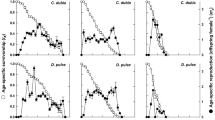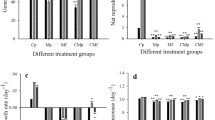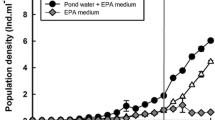Abstract
We hypothesized that cyclopoids, being predators, have a stronger allelopathic influence than calanoids on life-history variables of herbivorous rotifers. To test this hypothesis, we quantified the allelopathic effects of conditioned medium obtained separately from males and females of a calanoid (Arctodiaptomus dorsalis) and a cyclopoid (Mesocyclops longisetus) on the life table demography of the rotifer Brachionus havanaensis. The conditioned medium of the male and female A. dorsalis and male M. longisetus caused a significant reduction (14–18%) in the life expectancy at birth of B. havanaensis. Gross and net reproductive rates of rotifers reduced significantly on the conditioned medium of male or female A. dorsalis; however, the conditioned medium from either sex of M. longisetus had no significant effect on these variables. The population growth rate, r, varied from 0.53 to 0.64 d−1 depending on the treatment; the r was significantly lower when cultured on the conditioned medium from A. dorsalis (males or females) and female M. longisetus Contrary to our hypothesis, calanoid allelochemicals adversely affected the life history variables of rotifers more than those produced by the cyclopoids.


Similar content being viewed by others
References
Adrian R (2003) Calanoid-cyclopoid interactions: Evidence from an 11-year field study in a eutrophic lake. Freshw Biol 38:315–325. https://doi.org/10.1046/j.1365-2427.1997.00215.x
Borowitzka MA, Borowitzka LJ (1988) Micro-algal biotechnology Cambridge University Press, London
Brandl Z (2005) Freshwater copepods and rotifers: predators and their prey. Hydrobiologia 546:475–489. https://doi.org/10.1007/1-4020-4408-9_49
Chase JM, Abrams PA, Grover JP, Diehl S, Chesson P, Holt RD, Richards SA, Nisbet RM, Case TJ (2002) Review. The interaction between predation and competition: a review and synthesis. Ecol Lett 5:302–315
Conde-Porcuna JM (2000) Relative importance of competition with Daphnia (Cladocera) and nutrient limitation on Anuraeopsis (Rotifera) population dynamics in a laboratory study. Freshw Biol 44:423–430
Cuthbert RN, Dalu T, Wasserman RJ, Weyl OLF, Froneman PW, Callaghan A, Dick JTA (2020) Examining intraspecific multiple predator effects across shifting predator sex ratios. Basic Appl Ecol 45:12–21. https://doi.org/10.1016/j.baae.2020.03.002
Diéguez MC, Gilbert JJ (2002) Suppression of the rotifer Polyarthra remata by the omnivorous copepod Tropocyclops extensus: predation or competition. J Plankton Res 24:359–369. https://doi.org/10.1093/plankt/24.4.359
Gama Flores JL, Sarma SSS, López Rocha AN, Nandini S (2019) Effects of cladoceran-conditioned medium on the demography of brachionid rotifers (Rotifera: Brachionidae). Hydrobiologia 844:21–30. https://doi.org/10.1007/s10750-018-3853-z
Gama-Flores JL, Huidobro-Salas ME, Sarma SSS, Nandini S (2011) Effects of predator (Asplanchna) type and density on morphometric responses of Brachionus calyciflorus (Rotifera). Allelopath J 27:289–300
García CE, Chaparro-Herrera DJ, Nandini S, Sarma SSS (2007) Life history strategies of Brachionus havanaensis subject to kairomones of vertebrate and invertebrate predators. Chem Ecol 23:303–313
García CE, Nandini S, Sarma SSS (2011) Demographic characteristics of the copepod Acanthocyclops americanus (Sars, 1863) (Copepoda: Cyclopoida) fed mixed algal (Scenedesmus acutus)-rotifer (Brachionus havanaensis) diet. Hydrobiologia 666:59–69
Garza-Mouriño G, Silva-Briano M, Nandini S, Sarma SSS, Castellanos-Páez ME (2005) Morphological and morphometrical variations of selected rotifer species in response to predation: a seasonal study of selected brachionid species from Lake Xochimilco (Mexico). Hydrobiologia 546:169–179. https://doi.org/10.1007/s10750-005-4114-5
Gilbert JJ (1988) Suppression of rotifer populations by Daphnia: a review of the evidence, the mechanisms, and the effects on zooplankton community structure. Limnol Oceanogr 33:1286–1303. https://doi.org/10.4319/lo.1988.33.6.1286
Gilbert JJ (2013) The cost of predator-induced morphological defense in rotifers: experimental studies and synthesis. J Plankton Res 35:461–472. https://doi.org/10.1093/plankt/fbt017
Gilbert JJ (2017) Non-genetic polymorphisms in rotifers: environmental and endogenous controls, development, and features for predictable or unpredictable environments. Biol Rev 92:964–992
Gilbert JJ (2018) Morphological variation and its significance in a polymorphic rotifer: environmental, endogenous, and genetic controls. Bioscience 68:169–181
Grebner W, Berglund EC, Berggren F, Eklund J, Harðadóttir S, Andersson MX, Selander E (2019) Induction of defensive traits in marine plankton—new copepodamide structures. Limnol Oceanogr 64:820–831
Gross E, Garric J (ed) (2019) Ecotoxicology. New challenges and new approaches. Elsevier, London.
Heuschele J, Selander E (2014) The chemical ecology of copepods. J Plankton Res 36:895–913. https://doi.org/10.1093/plankt/fbu025
Heuschele J, Nemming L, Tolstrup L, Kiørboe T, Nylund GM, Selander E (2016) The sex specific metabolic footprint of Oithona davisae. J Sea Res 117:1–6. https://doi.org/10.1016/j.seares.2016.09.004
Kammenga J, Laskowski R (2000) Demography in ecotoxicology. Wiley, New York
Kiørboe T, Bagøien E (2005) Motility patterns and mate encounter rates in planktonic copepods. Limnol Oceanogr 50(6):1999–2007. https://doi.org/10.4319/lo.2005.50.6.1999
Kiørboe T (2006) Sex, sex-ratios, and the dynamics of pelagic copepod populations. Oecologia 148:40–50
Krebs CJ (1985) Ecology: the experimental analysis of distribution and abundance, 3rd edn. Harper & Row, New York
Le Bourlot V, Tully T, Claessen D (2014) Interference versus exploitative competition in the regulation of size-structured populations. Am Nat 184(5):609–623. https://doi.org/10.1086/678083
Long JD, Smalley GW, Barsby T, Anderson JT, Hay ME (2007) Chemical cues induce consumer-specific defenses in a bloom-forming marine phytoplankton. Proc Natl Acad Sci USA 104(25):10512–10517. https://doi.org/10.1073/pnas.0611600104
Loose CJ, von Elert E, Dawidowicz P (1993) Chemically induced diel vertical migration in Daphnia: a new bioassay for kairomones exuded by fish. Arch Hydrobiol 126:329–337. https://doi.org/10.1007/BF02029942
Makler-Pick V, Hipsey MR, Zohary T, Carmel Y, Gal G (2017) Intraguild predation dynamics in a lake ecosystem based on a coupled hydrodynamic-ecological model: the example of Lake Kinneret (Israel). Biology (basel) 6:22. https://doi.org/10.3390/biology6020022
Nandini S, Sarma SSS (2007) Effect of algal and animal diets on life history of the freshwater copepod Eucyclops serrulatus (Fischer, 1851). Aquat Ecol 41:75–84
Nandini S, Zúñiga-Juárez FS, Sarma SSS (2014) Direct and indirect effects of invertebrate predators on population level responses of the rotifer Brachionus havanaensis (Rotifera). Int Rev Hydrobiol 99:107–116. https://doi.org/10.1002/iroh.201301709
Noyon M, Froneman PW (2014) The diet of the calanoid copepod, Pseudodiaptomus hessei, in a permanently open southern African estuary inferred from fatty acid analyses. J Plankton Res 36(4):1153–1158. https://doi.org/10.1093/plankt/fbu037
Pitts RJ, Mozūraitis R, Gauvin-Bialecki A, Lempérière G (2014) The roles of kairomones, synomones and pheromones in the chemically-mediated behaviour of male mosquitoes. Acta Trop 132S:S26–S34
Pohnert G (2012) How to explore the sometimes unusual chemistry of aquatic defence chemicals. Chapter 13. In: Brönmark C, Hansson LA (ed). Chemical ecology in aquatic systems Oxford University Press. New York. https://doi.org/10.1093/acprof:osobl/9780199583096.003.0014
Poulet SA, Marsot P (1978) Chemosensory grazing by marine calanoid copepods (Arthropoda: Crustacea). Science 200(4348):1403–1405. https://doi.org/10.1126/science.200.4348.1403
Reid JW, Williamson CE (2009) Chapter 21 – Copepoda. In: Thorp JH, Covich AP (eds) Ecology and classification of north american freshwater invertebrates. Elsevier, Amsterdam, Third Edition, pp 829–899
Sarma SSS, Guevara-Franco JA, Almaraz-Ornelas B, Nandini S (2018) Interspecific effects of allelochemicals of 4-species of Brachionidae (Rotifera: Monogononta) on the population growth. Allelopath J 45:277–290. https://doi.org/10.26651/allelo.j./2018-45-2-1193
Sarma SSS, López Rocha AN, Nandini S (2020) Changes in life histories of cladocerans (Cladocera) from the rotifer-mediated allelochemicals. Chem Ecol 36:637–650. https://doi.org/10.1080/02757540.2020.1767082
Sarma SSS, Miracle MR, Nandini S, Vicente E (2019) Predation by Acanthocyclops americanus (Copepoda: Cyclopoida) in the hypertrophic shallow waterbody, Lake Albufera (Spain): field and laboratory observations. Hydrobiologia 829(1):5–17. https://doi.org/10.1007/s10750-018-3546-7
Sarma SSS, Nandini S (2018) Allelopathic interactions in freshwater ecosystems with special reference to zooplankton. In: Kaul BL (ed) Advances in fish and wildlife ecology and biology Vol. 7. Astral International Pvt. Ltd., New Delhi. pp 195–221.
Sarma SSS, Sagrario MH, Nandini S (2010) Allelopathic interactions between the predator (Asplanchna brightwellii) and prey (Brachionus calyciflorus) for coexistence. Allelopath J 26(1):131–138
Selander E, Kubanek J, Hamberg M, Andersson MX, Cervin G, Pavia H (2015) Lipid alarm signals in plankton. Proc Natl Acad Sci 112:6395–6400. https://doi.org/10.1073/pnas.1420154112
Snell TW, Morris PD (1993) Sexual communication in copepods and rotifers. Hydrobiologia 255:109–116
Snell TW (2017) Analysis of proteins in conditioned medium that trigger monogonont rotifer mictic reproduction. Hydrobiologia 796:245–253. https://doi.org/10.1007/s10750-016-2936-y
Snell TW, Joaquim-Justo C (2007) Workshop on rotifers in ecotoxicology. Hydrobiologia 593:227–232
Soumare MK, Cilek JE (2011) The effectiveness of Mesocyclops longisetus (Copepoda) for the control of container-inhabiting mosquitoes in residential environments. J Am Mosq Control Assoc 27:376–383. https://doi.org/10.2987/11-6129.1
van Someren GH, Almeda R, Lindegren M, Kiørboe T (2017) Gender-specific feeding rates in planktonic copepods with different feeding behavior. J Plankton Res 39:631–644. https://doi.org/10.1093/plankt/fbx033
Wallace RL, Snell TW, Ricci C, Thomas N (2006) Rotifera. 1. Biology, ecology and systematics. Backhuys Publishers, Leiden.
Weber CI (1993) Methods for measuring the acute toxicity of effluents and receiving waters to freshwater and marine organisms. 4th ed. United States Environmental Protection Agency. EPA/600/4–90/027F, Cincinnati.
Acknowledgements
This study formed part of Master’s thesis of the first author. The first author is grateful to CONCyT-CVU-842760 for a scholarship. This work was supported by a project from PAPIIT-IG200820. We thank José Luis Gómez Márquez and Pedro Ramírez García for comments on a draft version the manuscript. Marcelo Silva Briano and Martha Angélica Gutiérrez-Aguirre confirmed the copepod species identification.
Author information
Authors and Affiliations
Corresponding author
Ethics declarations
Conflict of interest
The authors declare that they have no conflicts of interest.
Human and animal participants
National guidelines for the care and use of laboratory animals were followed. The data from this study are not openly available but can be obtained from the corresponding author at request.
Additional information
Publisher's Note
Springer Nature remains neutral with regard to jurisdictional claims in published maps and institutional affiliations.
Handling Editor: Olivier P. Thomas
Rights and permissions
About this article
Cite this article
López-Rocha, A.N., Sarma, S.S.S. & Nandini, S. Allelopathic effects of male and female calanoids and cyclopoids (Copepoda) on the demographic response of Brachionus havanaensis (Rotifera). Aquat Ecol 56, 399–407 (2022). https://doi.org/10.1007/s10452-021-09937-3
Received:
Accepted:
Published:
Issue Date:
DOI: https://doi.org/10.1007/s10452-021-09937-3




